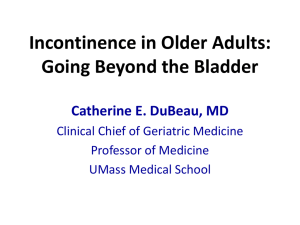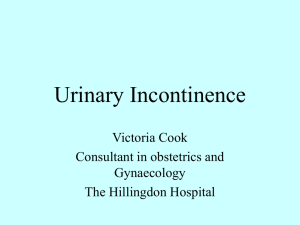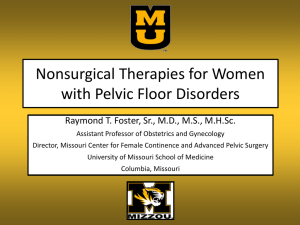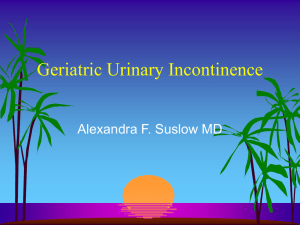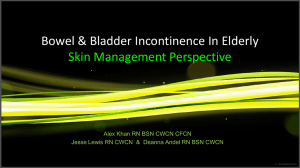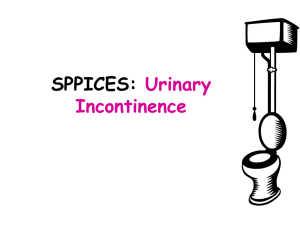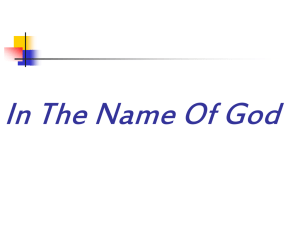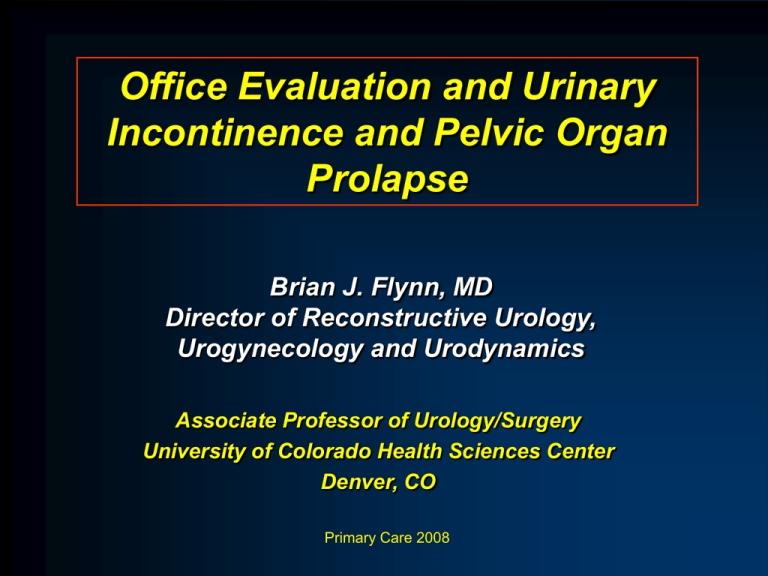
Office Evaluation and Urinary
Incontinence and Pelvic Organ
Prolapse
Brian J. Flynn, MD
Director of Reconstructive Urology,
Urogynecology and Urodynamics
Associate Professor of Urology/Surgery
University of Colorado Health Sciences Center
Denver, CO
Primary Care 2008
Primary Care 2008
Office Evaluation of Incontinence
and Prolapse
I. History and Physical
II. Diagnostic Tests
III. Office Management
- Behavioral
- Medical
- Procedural
Primary Care 2008
Objectives
Voiding Dysfunction
Defined as a failure to store or empty urine
Understand the current management of
office evaluation of voiding dysfunction
over active bladder (OAB)
Primary Care 2008
Urinary Incontinence and Pelvic Organ Prolapse
Epidemiology
Urinary incontinence *
10-20%, aged 15-64 years
30-40%, > 60 years
50%, long-term care facility
Pelvic Organ Prolapse † ‡
50%, > 50 years of age
30-50%, lifetime prevalence
354,962 operations/year, US data (1997)
Females patients comprise 40% of a general
urology practice
*
Iselin, CE and Webster, GD: Urol Clin N Amer 1998
Samuelsson, EC, et al.: Am J Obstset Gyencol 1999
‡ Suback, LL, et al.: Obstet Gynecol 2001
†
Primary Care 2008
How Many People Have
Incontinence?
13
million Americans of all ages
suffer from urinary incontinence
Women account for nearly 85%
Primary Care 2008
What Is Incontinence?
Incontinence is the unintentional release of urine
Embarrassing; unpredictable condition; it can
cause women to:
•
•
•
•
Avoid an active lifestyle
Shy away from social situations
Constantly search for the nearest bathroom
Become too embarrassed to talk to their doctor
Primary Care 2008
Urinary Incontinence
A Hidden Condition *
Two-thirds of patients are symptomatic for 2
years before seeking treatment
30% of patients who seek treatment receive
no assessment
Nearly 80% are not examined
Patients self-manage by voiding frequently,
reducing fluid intake and wearing pads
Primary Care 2008
* Survey conducted by Gallup Group (European Study)
Urinary Incontinence
Barriers to Treatment
Patient misconceptions and fears
“Normal part of aging”
“Not severe or frequent enough to treat”
“Too embarrassing to discuss”
“Treatment won't help”
Primary Care 2008
Are There Different Types of
Incontinence?
4
Types
•
Overflow
• Urge
• Stress
• Mixed
Primary Care 2008
Classification of Incontinence
Symptom Categories *
Stress incontinence
Urge incontinence
Unconscious incontinence
Continuous leakage
Nocturnal enuresis
Post-void dribble
Extra-urethral incontinence
Geriatric incontinence
*
Romanzi and Blaivis, Urol Clin North Am 1995
Primary Care 2008
Office Evaluation of UI and POP
Goals *
•
•
•
•
•
•
Nature of incontinence
Duration of incontinence
Degree of interference with lifestyle/activities
Predisposing medical/surgical conditions
Prior medical/surgical therapies for incontinence
Presence of pelvic floor relaxation
Direct appropriate and effective therapy
Primary Care 2008
Office Evaluation of UI and POP
Female Bladder Questionnaire
INITIAL HISTORY AND PHYSICAL
FEMALE
University of Colorado Hospital
(This section to be completed by patient)
DIVISION OF UROLOGY
Patient Name___________________________________Medical Record # ___________________
Date_______________________________ Age________ Phone__________________________________
Chief Complaint (Why you want to see the doctor today?):
_______________________________________________________________________________________
________________________________________________________________________________________
________________________________________________________________________________________
Bladder SYMPTOM QUESTIONNAIRE (circle symptoms that are present now)
(Please be sure to complete the bladder diary you were sent)
How often do you urinate: during the day? ___________________ during the night?
Is the amount of urine you usually pass :
Large
Average
Small
Do you have difficulty starting your urinary flow?
Yes
No
Do you strain to void your urine? Yes
No
Is your urine flow (circle one)
Strong Weak Dribbling Intermittent
Do you feel that you empty your bladder completely?
Yes
No
Do you notice dribbling of urine after voiding?
Yes
No
Do you have to assume abnormal positions to urinate? Yes
No
Primary Care 2008
Screening and Diagnosis of
Overactive Bladder
“Do you have bladder problems
that are troublesome or do you
ever leak urine?”
YES
Assess history, symptoms,
and test results
Establish a diagnosis
Primary Care 2008
Office Evaluation of UI and POP
Past History
Medical History
•
Diabetes mellitus
•
•
GI complaints/Constipation
Neurological disorders
– Prior CVA
– Multiple sclerosis
– Parkinson’s disease
Surgical
•
•
•
•
Incontinence and prolapse surgery, hysterectomy
Radical pelvic surgery (prostatectomy, APR)
Spinal surgery
Bladder outlet procedures
Primary Care 2008
Office Evaluation of UI and POP
Obstetrical/Gynecological
Number of children (vaginal or cesarean)
Vaginal deliveries
•
•
•
Number
Large birth weight
Forceps delivery
Menopausal status
•
Estrogen replacement
Primary Care 2008
Office Evaluation of UI and POP
SUI Subjective Data
Precipitating events
•
•
•
Minimal provocation: quiet walking, bending
Moderate provocation: coughing, sneezing
Significant provocation: strenuous exercise
Magnitude of stress incontinence
•
•
•
Drops v. complete void
Frequency of episodes
Type of pads used: liners, maxipads or diapers
– How many used daily
– Changed when wet, damp or dry (changed by habit)
Primary Care 2008
Office Evaluation
Urge Incontinence
Triggers
•
•
•
“Urge
•
“Key in the door”, hand washing
Rising from the seated position
Coughing, walking, jumping
Syndrome” symptoms
•
Frequency
Nocturia
Urgency
•
Urge incontinence
•
Primary Care 2008
OAB and Stress Incontinence
Differential Diagnosis
History and Physical Examination
Symptom Assessment
Overactive
bladder
Yes
Stress incontinence
Frequency with urgency
(>8 times/24 h)
Yes
No
Leaking during physical activity;
eg, coughing, sneezing, lifting
No
Yes
Amount of urinary leakage with
each episode of incontinence
Ability to reach the toilet in time
following an urge to void
Waking to pass urine at night
Large
(if present)
Small
Often no
Yes
Usually
Seldom
Symptoms
Urgency (strong, sudden desire to
void)
Primary Care 2008
Abrams P, Wein AJ. The Overactive Bladder:
A Widespread and Treatable Condition. Erik Sparre Medical AB; 1998.
No
Urinary Incontinence
Differential Diagnosis *
Stress
Urge
Condition
•
Urethral hypermobility
ISD
Causes
Condition
Causes
Pelvic floor relaxation
Prior pelvic surgery
Neurogenic
•
•
•
•
•
*
Detrusor overactivity
Idiopathic
Neurogenic
UTI
Bladder cancer
Outlet obstruction
Romanzi and Blaivis, Urol Clin North Am 1995
Primary Care 2008
Office Evaluation of UI and POP
Physical Examination
Abdominal
•
•
•
prior surgical scars
distended bladder
obesity
•
•
Back/Spine
•
Neurological
skeletal deformities
scars from trauma/surgery
tuft of hair, skin dimple
Primary Care 2008
mental status
sensory function
motor function
reflex integrity
Office Evaluation of UI and POP
Pelvic Examination
Moderately full bladder
Components
• Visual inspection
• Speculum exam
• Assessment of pelvic floor strength
• Bimanual exam
Primary Care 2008
Office Evaluation of UI and POP
Pelvic Examination
Inspection
•
Labia
•
•
Introitus
•
•
•
Signs of estrogenization
Atrophy/stenosis
Posterior injury from childbirth
Perineum
•
Wide perineum or posteriorly displaced anus may
indicate weakened perineal body/pelvic muscle atrophy
Primary Care 2008
Office Evaluation of UI and POP
Speculum Examination
Systematic
•
•
•
Anterior vaginal wall and urethra
Vaginal apex
Posterior vaginal wall
Valsalva/strain or cough
Stage
•
Baden-Walker (halfway down v. POPQ)
Primary Care 2008
Office Evaluation of UI and POP
Anterior Compartment
Urethral or bladder decent
+/- Q-tip test
Incontinence (Quantity relative to valsalva)
Cystocele
Lateral defect
•
Corrected by replacing the lateral fornices to the
sidewall (using ring forceps)
Central defect
•
Smooth surfaced (loss of rugae) herniation not
corrected by lateral replacement
Primary Care 2008
Office Evaluation of UI and POP
Vaginal Apex and Posterior Compartment
Position of cervix or vaginal cuff
•
•
Rectocele
Cervical descent with straining
Cervical mucosal appearance
Bulge close to the introitus generally
Confirm with simultaneous DRE
Graded similar to cystocele
Enterocele
Bulge generally higher in vault
Bidigital rectovaginal exam essential
Primary Care 2008
Office Evaluation of UI and POP
Objective Data
•
•
•
•
•
Voiding diary
Pad weight test
Laboratory tests
Cystourethroscopy
Urodynamics
• Eyeball urodynamics
• Multichannel urodynamics
Primary Care 2008
Office Evaluation
Voiding Diary (3-5 days)
Date, time and volume of each void
Record of each incontinent episode
•
•
•
time
amount
precipitating cause of leakage
Poor correlation between patient’s recalled history of nature/
volume/frequency of incontinent events and voiding diary
Primary Care 2008
Office Evaluation of UI and POP
Pad Weight Test
Only truly objective measure of incontinence
1ml urine roughly equals 1gm
Weight of wet pad minus sample dry pad
24-hour test best for urge and stress
incontinence
1-hour pad test standardized by ICS good
measure of SUI
Primary Care 2008
Office Evaluation of UI and POP
Laboratory Evaluation
Urine analysis and culture
BUN and creatinine
Hematuria
• Cytology
• Upper tract evaluation (IVP or CT)
• Cystoscopy
Primary Care 2008
Office Evaluation of UI and POP
Cystoscopy
Urethra
•
•
Urethritis (shaggy, erythematous, painful mucosa),
atrophy (pale), diverticulum, FB
Stricture
Bladder
•
•
•
•
•
Outlet (contracture, BPH)
Neoplasia
Ureteral orifice (location and number)
Diverticuli
Calculi and foreign bodies
Not usually required in most patients, but generally helpful
in patients with prior surgery
Primary Care 2008
Office Evaluation of UI and POP
Urodynamics *
Not generally required in most patients with
uncomplicated incontinence
In neurologically intact patients, one can proceed with
noninvasive empiric therapy if history, physical and
urinalysis do not suggest serious pathology
*
Erickson and Davies, AUA update series, 1999 (11)
Primary Care 2008
Office Evaluation of UI and POP
Urodynamics *
Indications
•
•
•
•
•
* Iselin
Initial tests inconclusive
Prior corrective surgery for incontinence
Prior radical pelvic surgery or radiotherapy
Neurologic disorder
Mixed stress/urge with unclear relative
contribution
and Webster, Urol Clin N Amer 1998
Primary Care 2008
Behavioral Management
Primary Care 2008
Management of Urinary Incontinence
Behavioral Modifications
Timed
Voiding
Education
Pelvic Floor
Exercises
Behavioral
Modification
Reinforcement
Primary Care 2008
Delayed
Voiding
Office Treatment of Urinary Incontinence
Behavioral Therapy
“Force the patient to store larger volumes of urine
under conditions of physical activity and urgency by
using the pelvic floor to maintain continence and to
inhibit the detrusor”
•
•
•
Fluid and dietary modification
Bladder retraining
Pelvic floor reeducation
Iselin and Webster, Urol Clin N Amer 1998
Primary Care 2008
Office Treatment of Urinary Incontinence
Fluid and Dietary Modification
Fluid restriction often practiced and often
counterproductive
•
•
Concentrated urine, irritating, increased odor
Increased urgency and frequency
Drink small amounts often, usually before 7pm
Increase intake in hot weather or exercise
Avoid bladder irritants
•
Coffee and tea, carbonated beverages, chocolate, spicy
and tomato based foods
Avoid constipation, which contributes to urgency
•
Increased fiber and fluid intake
Primary Care 2008
Management of Urinary Incontinence
Biofeedback
Monitoring instruments to
detect and amplify
internal unconscious
functions
EMG v. manometric devices
Can significantly improve
success rates to 50%
with reeducation
alone, to 90% with
biofeedback
Primary Care 2008
Pharmacologic Management of
OAB
Primary Care 2008
Management of OAB
ICS Definition
Urgency, with or without incontinence,
usually with frequency and nocturia
In the absence of a pathologic or metabolic
condition that might explain these symptoms
International Continence Society: 2002
Primary Care 2008
Office Evaluation
Urge Incontinence
Rule-out neurological disorders
•
•
•
•
•
Radicular pain
Paresthesias
Muscle weakness
Diminished sensation
Ocular symptoms (MS)
Bladder outlet obstruction
Risk factors for TCC of the bladder
Primary Care 2008
Distribution of Muscarinic Receptors
Muscarinic receptors
are
Abrams P, Wein AJ. The Overactive Bladder—A Widespread and Treatable Condition. 1998.
also located in the
CNS.
Primary Care 2008
Management of OAB
Pharmacologic Therapy
Antimuscarinic agents are the mainstay
OAB symptoms relieved by
•
inhibition of involuntary bladder contractions
• increased bladder capacity
Treatment limited by side effects
•
dry mouth
• dry eyes, blurred vision
• constipation, GERD
• CNS effects
Primary Care 2008
Anticholinergic Agents
Oxybutynin Immediate Release (OXY-IR)
It is a tertiary amine that is smooth muscle relaxant that facilitates
bladder storage
Pharmacodynamic properties
• Extensive first-pass hepatic metabolism by cytochrome P450
enzyme (CYP3A4) into many active metabolites
• The primary active metabolite is N-desethyloxybutynin
(N-DEO) has been implicated as the cause of side effects
• Side effects
• dry mouth, dry eyes, constipation, CNS impairment
Contraindicated in patients with glaucoma
Oxy-IR 2.5-5 mg po TID
Primary Care 2008
Anticholinergic Agents
Oxybutynin Extended release (XL)
•
•
•
•
•
OXY-ER is designed to pass through the upper GI tract
OXY-ER is metabolized primarily in the colon
This delays absorption and reduces first-pass effect
Results in reduced N-DEO levels compared to OXY-IR
OXY-ER has equivalent efficacy to OXY-IR, improved dosing and
side-effect profile
• Extended release (XL) 5-10 mg po QD
Appel RA, et al.: OBJECT Study, Mayo Clin Proc 2001
Diokno AC, et al.: OPERA Trial, Urology 2003
Primary Care 2008
Anticholinergic Agents
Oxybutynin Transdermal Delivery System (OXY-TDS)
•
Rationale
• Oral bioavailability is low
• OXY-TDS avoids first-pass gastric and hepatic metabolism
•
Effective OXY-TDS dose is 3.9 mg/day
Results
•
OXY-TDS maintains a consistent delivery of OXY over a 96-hours
with marked reduction in the plasma concentrations of N-DEO
•
OXY-TDS has equivalent efficacy to OXY-IR and lower AEs
•
Primary AE is application site reaction (9% discontinuation)
Dmochowski RR, et al.: J Urol 2002
Primary Care 2008
Diokno AC, et al.: OPERA Trial, Urology 2003
Anticholinergic Agents
Tolterodine (Detrol)
It is a tertiary amine that is less lipid soluble then oxybutynin
and has a limited capacity to cross the blood-brain barrier
Pharmacodynamic properties
• Extensively metabolized by cytochrome P450 enzyme (CYP2D6)
and has a major active metabolite similar to parent compound
• Non selective muscarinic receptor antagonist
• Decreased frequency of voids
• Decreased urge incontinence episodes
Similar efficacy to oxybutynin-IR with better tolerance and fewer
drop outs
Continuation rates higher than with oxybutynin IR
•
•
Tolterodine IR 2 mg po BID
Tolterodine long acting (Detrol LA) 4 mg po QD
Van Kerrebroeck P, et al.: Urology 2001
Primary Care 2008
Anticholinergic Agents
Tropsium (Sanctura)
It is a quaternary amine that is less lipid soluble then
oxybutynin and does not cross the blood-brain barrier to the
same extent
Pharmacodynamic properties
• Competitive antagonist of ACh at postsynaptic binding sites
• Only anticholinergic that is not metabolized by cytochrome P450
rather it is excreted unchanged in the urine by tubular secretion
• Comparable selectivity for M1-M5 Efficacy
• Decreased frequency of voids
• Decreased urge incontinence episodes
• Onset within one week
Low GI absorption/low bioavailability
• <10% is absorbed; bioavailability is low at 9.6%
• Tropsium (Sanctura) 20-40 mg po BID
Fusgen I, et al.: Int J Clin Pharmacol Ther 2000
Zinner
et al.: J Urol 2004
Primary
CareN,
2008
Anticholinergic Agents
Darifenacin (Enablex)
Pharmacodynamic properties
• Metabolized by P450 isoforms CYP3A4 and CYP2D6
• Dose adjusted in patients taking potent CYP3A4 inhibitors
• Darifenacin has the greatest M3 affinity
• Decreased frequency of voids
• Decreased urge incontinence episodes
• M3 receptors are involved in contraction of the bladder, GI
smooth muscle, heart and saliva production
Darifenacin 7.5-15 mg po QD
Haab F, et al.: Eur Urol 2004
Chapple CR. J Urol 2004
Primary Care 2008
Anticholinergic Agents
Solifenacin (VESIcare)
A tertiary amine that is well absorbed by the GI tract
Pharmacodynamic properties
• Muscarinic antagonist with some M3 selectivity (10 fold)
• Metabolized by P450 isoform CYP3A4
• Elimination half-life following chronic dosing is
approximately 45 to 68 hours
Efficacy, safety and tolerability documented in phase III trials
• Significant reduction in frequency, urgency and urge
incontinence episodes
Solifenacin 5-10 po QD
Chapple CR, et al.: BJU Int 2004a
Chapple CR, et al.: BJU Int 2004b
Primary Care 2008
Management of Refractory
OAB
Primary Care 2008
Management of Refractory
OAB/PBS
Endoscopic procedures
•
•
•
•
•
•
Urethral dilation
Direct ulcer injection
Endoscopic resection
Laser therapy
Hydrodistention
Botox injection
•
•
•
•
Electrical stimulation
•
•
Denervation
Perc neuromodulation
Afferent nerve stimulator
Ingelman-Sundberg
Transvesical phenol
injection
Cystoloysis
Sacral rhizotomy
Cystoplasty
•
Autoaugmentation
• Enterocystoplasty
Stepwise approach in most
instances from least invasive to
most invasive
Urinary diversion
•
•
•
Primary Care 2008
Mitrofanoff
Conduit
Continent diversion
Management of Refractory OAB
Intravesical Botilinum Toxin (botox)
Botox is derived from the
organism C. botulinum
Inhibits the vesicular neuronal
blockade up to 9 mos
Increasing data on the benefits of
botox in patients with
• Non-neurogenic DO
• Neurogenic DO
• DSD
• Interstitial cystitis?
Schurch B, et al.: J Urol 2000
Smith CP and Chancellor
MB:Care
J Urol
Primary
20082004
Management of Refractory OAB
Intravesical Botilinum Toxin Type-A (botox)
Technique
Urethra
•
100 units in 2-3 ml of NS
•
Collagen needle used to
inject 3, 6, 9 and 12
o’clock positions in
striated sphincter
Bladder
• 200-300 units in 30 ml of NS
• Inject 30-40 sites within the
detrusor, targeting the
trigone, base of the
bladder and lateral walls
Schurch B, et al.: J Urol 2000
Primary Care
2008
Smith CP and Chancellor
MB:
J Urol 2004
Management of Refractory OAB
Interstim
Interstim™ has evolved from a large cut-down procedure over the
Primary Care 2008
sacrum to a less invasive percutaneous tined lead approach
Management of SUI
Primary Care 2008
What Causes SUI?
Pelvic muscle strain
Childbirth
Pelvic muscle tone loss
Estrogen loss/menopause
Primary Care 2008
More About SUI
Most prevalent type of incontinence
•
•
Affects women of all ages, young mothers, premenopausal women, seniors
•
You are not alone!
8 million women have SUI
Average age of onset: 48
Treatable condition
Primary Care 2008
The Impact of SUI
70% of women with SUI surveyed said they worry about
coughing, sneezing and even laughing in public for
fear of having an accident
35% report changing their activities to accommodate the
condition including avoiding exercise, traveling less
frequently and avoiding sex
62% waited a year or longer before even discussing their
condition with a doctor
Primary Care 2008
63
There is Treatment for SUI!
Self management
Medication
Biofeedback, electrical stimulation
Minimally invasive procedures
Primary Care 2008
Minimally Invasive Procedures
Common SUI surgical procedures
•
•
•
Bladder neck suspensions
Needle suspensions
Conventional sling procedures
Most treatments are
•
•
•
•
Invasive
Involve general anesthesia
Require hospital stay
Require extended recovery time (up to six weeks)
Primary Care 2008
TVT
How Does It Work?
Restores your body’s ability to control urine loss
•
•
Surgeon provides support to the urethra by placing a
"sling" or mesh tape beneath it
The tape supports the urethra during sudden movements,
such as a cough or sneeze, keeping the urethra closed
and preventing the involuntary loss of urine.
Primary Care 2008
Benefits
•Completed in 30 minutes
•Patient may be able to return home
the same day
•Reduced need for post-surgical
catheterization
•Short recovery time,
minimal pain
Primary Care 2008
Simple, Proven Treatment
Effective
•
•
•
86% cured,
11% report improvement
Follow-up studies show
that even years later women
stay dry
More than 500,000 women
worldwide have been treated
Primary Care 2008
What Are The Potential Risks?
All medical procedures contain some risk
Hemorrhage/hematoma
Injury to blood vessels, bladder or bowel
Difficulty with urination
Primary Care 2008
TVT-Obturator
Results
Convalescence
•
•
•
Mean operative time 28 minutes
All patients discharged same day without catheter
All patients returned to normal activity, with the
exception of heavy lifting, in < 7 days
Intra-Operative Complications
•
•
•
There were no to bladder, bowel or neural injury
1 intra-operative urethral injury was repaired and TVT-O
completed
Mean EBL 43 (0-300) ml
• no patient required a blood transfusion
Flynn BJ and
Myers
J: 2008
SC AUA 2005
Primary
Care
TVT-Obturator
Continence Outcome
•
•
•
Results
Mean follow-up 13.5 (2-23) months
76 of 82 (92.6%) patients cured
• 66 patients required 0 pads
• 10 patients averaged 1 ppd
6 of 82 (7.4%) patients were considered failures
• 5 patients with persistent/recurrent SUI (> 1 ppd)
Complications
•
•
4 case of bladder incomplete emptying or de novo urgency
required urethrolysis in 2
1 vaginal mesh extrusion noted at 6 weeks
• Multi-layer closure performed, no recurrent extrusion
Flynn BJ and Myers J: SC AUA 2005
Primary Care 2008
Tension-Free Vaginal Tape Secur (TVT-S™)
The Next Generation
*
Gynecare Inc., Summerville, NJ
1.1 x 8 cm of laser cut
polypropylene mesh
tape placed through a
small vaginal incision
under the mid-urethra
with no exit site
Can be placed as a ‘U” or “hammock”
Unique tension-free fixation mechanism
Primary Care 2008
Tension-Free Vaginal Tape Secur (TVT-S™)
Proposed Advantages
Can be done under local anesthesia, outpatient, no catheter,
ability to do cough test
Less invasive
Less dissection
Less pain
Less complicated
Less bleeding
Eliminate risk of bowel,
ureteral injury
Lower risk of retention
and de novo urgency
Primary Care 2008
Management of POP
Primary Care 2008
Etiology of Pelvic Organ Prolapse
Childbirth
Estrogen deficiency
Chronic intra-abdominal
pressure
•
Pulmonary disease
• Heavy lifting
• Chronic straining
Neuropraxia affecting
the pelvic floor
Primary Care 2008
Pelvic Organ Prolapse Prevalence
1
2
3
POP in > 50% of women over 501
Lifetime prevalence of 30-50%1
Women > 65 is the fastest growing segment of the
US population2
Demand for services expected to double in the next
30 years3
Subak et al. Obstet Gynecol 2001;98:646-651
US Census Bureau 2000 Int data base
Luber et al. Am J Obstet Gynecol 2001;184:1496-1501
Primary Care 2008
POP Procedural Demand
11% risk of surgical intervention by age 801
226,000 procedures performed in 19972
Cost > $1 billion3
Estimated number in 2030 is 7 million4
Represents a small subset of symptomatic patients
1
2
3
4
Olsen et al. Obstet Gynecol 1997;89:501-506
Brown et al. Am J Ob Gyn 2002;186:712-716
Subak et al. Obstet Gynecol 2001;98:646-651
Shull. Am J Ob Gyn 1999;181:6-11
Primary Care 2008
Management of Level I Defects
Expectant management
•
When is it appropriate?
Pessary placement
Surgical Correction
•
•
•
•
Vaginal
Abdominal
Combined
Laparoscopic
Primary Care 2008
Nonsurgical Management of Vaginal
Vault Prolapse
Kegel exercises
Reduce intrabdominal
pressure/straining
• Bowel regimen
• Weight reduction
• Eliminate heavy lifting
Pessary
Primary Care 2008
How are we doing with our current
surgical procedures?
11.1% lifetime risk of surgery
29-40% patients require
reoperation within 3 years1,2
60% of the recurrences are at
the same site3
32.5% of the recurrences are at
a different site3
1
Olson et al. Obstet and Gynecol 1997;89:501-506
Marchionni et al. J Reproduct Med 1999;44;679-684
3 Clark et al. Am J Obstet and Gynecol 2003;189:1261-1267
2
Primary Care 2008
PROLIFT System: Early Outcome Data1,2
Author
Groenen MJC
et.al.
(Netherlands)1
#
Pts
26
Mea
n
Age
Site
61
A-6
P-10
T-10
Perscheler M
et.al.
(Austria)1
80
N/A
Rivera JM
et.al .
(USA)2
82
63
Compiled
Data
1 IUGA
549
64
Complications
Vd.dysfcn-5
Exposure
1 (3.8%)
S=N/A
N/A
Cystotomy-2
Hematomas-2
8 (10%)
S=5 (50%)
P-19
T-63
Hematoma-1
Hemmorrhage-1
7 (11.7%)
S=N/A
A-109
P-85
T-256
Cystotomy- 1.7%
Rectal perf- 0.4%
Hemorrhagic1.3%
Void dysfcn- 6.7%
34 (6.2%)
S=12
(2.6%)
Length of
Follow Up
“Success”
(< Stage II)
2 mo.
26 (100%)
N/A
N/A
3 mo.
Not well
defined
6 mo.
81.4-100%
Care in:
2008
– Fatton - 2006 Abstracts allPrimary
published
Int Urogynecol J 2006;17(S.2):S212
2006 Abstract published in: Int Urogyn J 2006;17(S.3):S460
2 AUGS
Polypropylene mesh reinforced pelvic floor repair
and vaginal vault suspension (Prolift)
Operative Technique
Anterior Mesh Implant
Primary Care 2008
Resources
Where you can find more information:
www.nafc.org (National Association
for Continence)
www.simonfoundation.org
www.niddk.nih.gov (National Kidney
and Urologic Diseases Information
Clearinghouse)
Primary Care 2008

